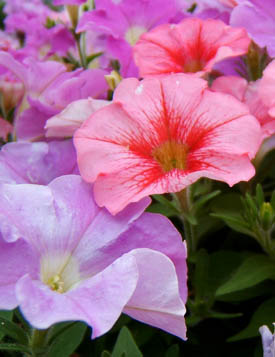
Lush and lively green blessings to you all! May your summer solstice be light-filled and joyous. (And a happy winter solstice to our readers down under.)
The sheer force of photosynthesis here in the Catskills is mind-altering. We have had plentiful rain and the green is tropical in its lushness: Leaf-heavy limbs hang to the ground. Vines curl everywhere, over everything. Fruit drenches the senses and weighs down the bushes, attracting darting birds. Dozens of shades of green compete for my attention. "Here!" "Over here!" "Harvest me!" "Me!" "Me!"
Now is the time to made lots of remedies. Our wine crock moves from one batch to the next: First dandelion flowers fermented into dandelion wine. Then creeping jenny flowering tops foamed for days before we could safely bottle their wine. And now the white snow of wild roses bubbles and seethes and awaits its turn to turn into wine.
Did you ever notice that old herbals give doses in wine glassfuls? That's because they fermented their herbs rather than making tinctures. They couldn't just go to the alcohol store and buy whatever they wanted. The alcohol soluble constituents of the plants extract into wine as well as into vodka if they are fermented out of the fresh plant. (Some aromatic plants – like sweet woodruff – need only be soaked in wine rather than being made into wine.)
There is still plenty of time to gather your plants and experiment with wines, vinegars, oils, and honeys. And don't forget to make lots of fresh plant tinctures, especially from the Great Remedies.
In our photo section, I introduce you to three more Great Remedies. These are the plants that novice and seasoned herbalist alike rely on year after year for their safe and dependable abilities. Get to know them, if you don't. If you do, learn one more way to use them, for their uses are endless and always amazing.
I had a great time at the Midwest Women's Herbal Conference with fabulous women, including my dear friend Aviva Romm, MD. What a fun time we had leading a weed walk together. Next week I will be teaching at the International Herb Symposium, one of my favorite conferences, held near Boston, MA. I know I shall have a splendid time there, as I have at each and every one of the previous IHS gatherings. See you there!
Changes are afoot at my mentorship site, as I continue to seek the best ways to help you discover the medicine outside your door and the simplest, easiest ways of using them. In the expanded ezine, the mentor groups are finishing their core study of plantain. And perhaps they are thinking ahead to next month's core study: Choosing and working with your green ally. Do join us.
Here are three more Great Remedies for you, all used primarily internally, as opposed to last week's trio, which are mostly used externally. Of those, yarrow and plantain may also be made into a fresh herb tincture; the yarrow while flowering, the plantain at any time. I do not use comfrey tincture.
St. J's, St. Joan's wort, St. John's wort (Hypericum perforatum)
Oh flower of the sun, flower of the solstice, bless us, bliss us. Let us keep your summer magic for our winter use. Permit us to capture your light in oil. Allow us to bottle your inner glow. Grace us with your red-lipped smile in our tinctures. Allow us to capture your innermost power. Oh, flower of the sun, ease our muscle pain, help us stay strong and flexible. Oh flower of solstice, lift our mood and let us be your emissary of delight. Bless us, bliss us. Flower of the sun, flower of the fire, flower of St. Joan, protect us from burning, protect our skin against harm. Flower of the solstice protect us from viral infections, protect us from invisible harms. Flower of the sun, flower of the solstice, bless us, bliss us. Smile on us.
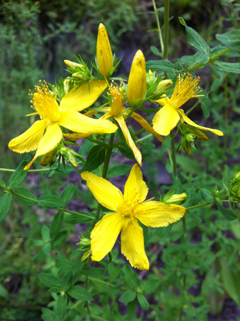 Motherwort (Leonurus cardiaca)
Motherwort (Leonurus cardiaca)
Thanks to Justine Smythe for this exquisite photo of the flowers of motherwort, one of my favorite remedies for both men and women. Motherwort flowering top tincture not only strengthens the muscles of the heart and the uterus, it establishes a regular rhythm in both organs. Motherwort is nothing less than amazing in its ability to calm those who are anxious. It eases menstrual cramps, assists at birth, calms a rapid heartbeat, helps smooth the rough parts of our menopausal journey, and is said to be "the herb of longevity" in Japan. The tea is way too bitter for pleasant consumption; so is the tincture made from dried motherwort. Stick to the fresh plant tincture; it tastes like (cheap) chocolate; yummy.
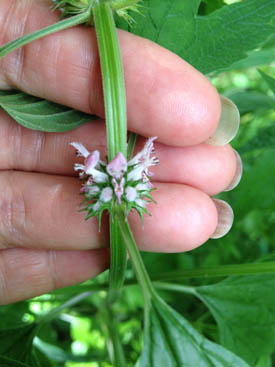 Mullein (Verbascum thapsus)
Mullein (Verbascum thapsus)
This common roadside weed is known as the "lungs of the earth." It nourishes and restores the lungs from the bronchioli to the trachea. I harvest mullein to dry for infusion by cutting the flowering stalk just before the flowers open. I hang each stalk individually and store, when dry, in brown paper bags. Before using it, I use heavy garden pruning shears to cut the mullein stalk and leaves into 1-2 inch pieces. To make Lung Healing Mullein Milk: first making a mullein infusion by steeping one ounce of dried mullein in a quart of boiling water for at least four hours. The resulting dark brown brew is strained through a cloth to remove the ultra-fine hairs, them mixed half and half with whole milk, heated to piping hot, sweetened with a little honey. This may be drunk freely by those seeking to stop smoking, those who have stopped smoking, anyone with a chronic or acute cough, those with asthma and allergies affecting breathing, and anyone who has previously had pneumonia.
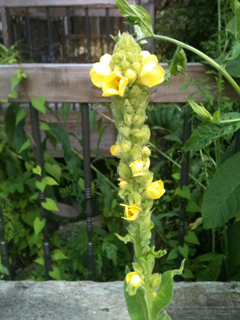
Fresh flowering herb tincture
Dose of motherwort is 5-25 drops, as often as needed.
Dose of mullein is 10-40 drops, 1-4 times a day.
Dose of St. J's is 1-20 dropperfuls a day.
- Harvest the flowering tops of motherwort, mullein, or St. J's at noon or later on a bright, sunny day when there has not been rain for at least 24 hours.
- Chop the stalks, leaves, flowers, flower buds, and developing seeds of the one plant you have chosen into pieces no longer than an inch and a half.
- Fill your jar right up to the top with the fresh, chopped herb.
- Then fill the jar to the top with 100 proof vodka. (No, 80 proof will not work.)
Cap tightly. Label, including the botanical name of the plant and the date.
Keep in a cool, dark place.
Your tincture is ready to use after six weeks but may be left for years without harm.
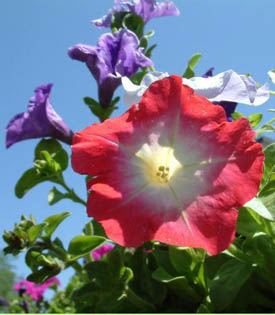
Glorious Green Greetings to All
The apprentices and I have harvested the last of the nettles to dry. What we haven't gotten to will go to seed, and we will harvest those seeds this autumn. Except for those we will continue to harvest throughout the summer to make nettle rot fertilizer to feed the garden plants.
Now that nettle gathering is complete, we can devote ourselves more herbs ready to harvest: prickly flowering comfrey stalks and picky red clover blossoms. The students at the Great Remedies class last weekend helped us pick a big basket full of perfect red clover blossoms. Many hands make the work go quickly. Thank you!
A wild wind blew through last week and shook all the mulberries from the mulberry trees. The apprentices picked them up and started a mulberry wine. Then we went out and picked elder blossoms so we could make elder flower champagne and elder flower tincture.
Speaking of which, both elder and mullein told me they are irked at me for not including them in the Great Remedies class. (We talked about nettle, red clover, comfrey, linden, oatstraw, plantain, yarrow, and motherwort.)
"But the students can only learn so much in one day," I protested. "After we cut young nettle from the soup patch, harvested shiitake (thanks Sean) from the shiitake logs, added both to boiling water, and dropped in some dried astragalus root to make ourselves a delicious soup. And after we harvested and made a salad of sheep sorrel, wood sorrel, yellow dock leaves, lamb's quarter, creeping jenny, self-heal, five-finger ivy, mallow leaves, wild oregano, plantain, and clover blossoms. And after we harvested nettle and hung it to dry; and harvested comfrey and hung it to dry. And harvested yarrow flowers and made a tincture. And then harvested flowering motherwort and made a tincture. Well, I had intended to include you both, but there just wasn't enough time." (They are still annoyed. Burdock and yellow dock are content to wait until autumn, when they star in the Digging Roots class late this fall.)
This week I bring you the sour herbs of summer. Get ready to make friends with some tarts in the true sense of the word
Pucker Up for Sour Plants
The sour taste is ideal for summer. Like lemons, plants with sour tastes help us stay cool in the hot days. Lemony-tasting plants like lemon balm and lemon verbena are not what I mean though. I am talking about plants that are a sour as lemons, those that make you pucker up. Here are my favorites. (Note how many of them have "sorrel" in their names.)
Wood sorrel (Oxalis stricta)
With its leaves in threes, oxalis is often mistaken for a clover, even to the point of being called "sour clover." But clover leaves are oval, and oxalis leaves are heart-shaped. And, of course, no clover is sour. This one is really tart. You will get a good pucker from it. My granddaughter has picked and eaten this plant with relish since she learned to identify it around age 2. The perky yellow flowers help the eye pick it out of the surrounding mass of greenery. Look for wood sorrel in the garden, not the woods. Though there are varieties that do inhabit the woods, they are not common on the east coast. All varieties of oxalis are edible, even the cultivated ones. Enjoy this great sour taste in your salad today!
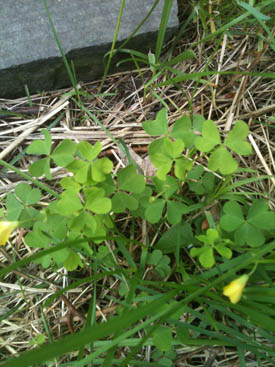 Sheep sorrel (Rumex acetosella)
Sheep sorrel (Rumex acetosella)
This is another small plant with a large taste. It is perhaps the sourest of all, definitely worthy of a pucker up. The tiny red flowers are most visible at a distance, rather than up close, as this sorrel grows in patches along roadsides and in "waste" places. A large patch keeps my iris bed company, preventing other, larger, weeds from colonizing the bed. This sorrel does goes in the woods, in bare, open places. It is a favorite of mine both as a snack while I am out in the forest with the goats, and as a delicious addition to summer salads. Try some soon.
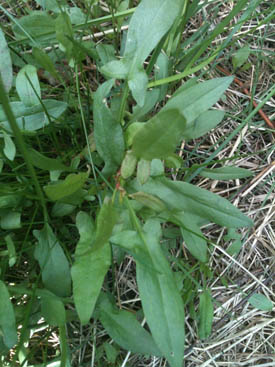
sheep sorrel
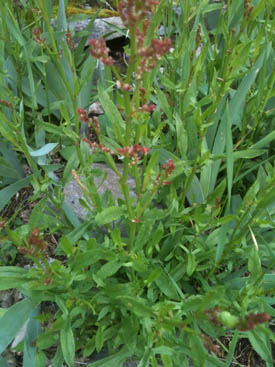
sheep sorrel in flower
Garden sorrel (Rumex acetosa)
Notice that the botanical name of this plant is nearly the same as the previous sorrel. That's because they are sisters. The ending "ella" means "little," so we know that sheep sorrel is a little variety of garden sorrel. I don't know which came first, the wild one or the cultivated one. In fact, I couldn't swear that garden sorrel is not developed from a yellow dock. At any rate, this is the cultivated member of the Rumex genus. And it has been bred and chosen for that yummy sour taste. If you don't have one in your garden,
Johnny's Selected Seeds in Vermont and
Richter's in Ontario can help you.
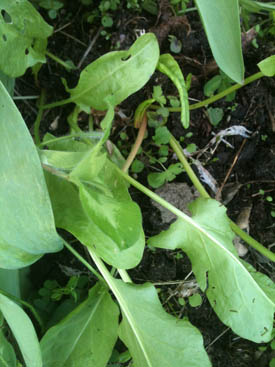 Curly dock, Yellow dock (Rumex crispus)
Curly dock, Yellow dock (Rumex crispus)
There are many dock with yellow roots that are used medicinally, and they are all known as yellow dock. But don't try eating the leaves of most of them. Only the curly dock provides edible leaves. The other docks are too bitter. If garden sorrel was jumped up from a yellow dock, then this is the most likely parent. With just a little tweaking, the sour taste in these leaves could be selected for and grown into a great pucker up plant. The youngest leaves of the curly dock are the best, and the most sour. Try them in my Pucker Up Salad, or use them to make the classic soup Shav.
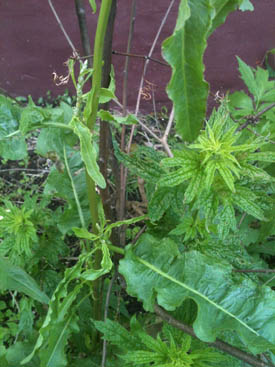 Enjoy some of these plants in your Pucker Up Salad!
Pucker up salad
Serves 4
Enjoy some of these plants in your Pucker Up Salad!
Pucker up salad
Serves 4
Collect 25-30 woodbine leaves; separate leaflets and tear in half.
Collect ¼-½ cup of sheep sorrel/whalewort.
Collect oxalis as available.
Collect 6-10 curly dock leaves; cut finely.
Collect 1 cup chickweed tender tips.
Toss all greens together.
Garnish with rose petals or nasturtiums.
Serve with tamari, herbal vinegars,* extra virgin olive oil, gomasio, and a drizzle of maple syrup.
*
Burdock root vinegar and yellow dock seed vinegar are especially good choices.

 Lush and lively green blessings to you all! May your summer solstice be light-filled and joyous. (And a happy winter solstice to our readers down under.)
Lush and lively green blessings to you all! May your summer solstice be light-filled and joyous. (And a happy winter solstice to our readers down under.)

 Glorious Green Greetings to All
Glorious Green Greetings to All






